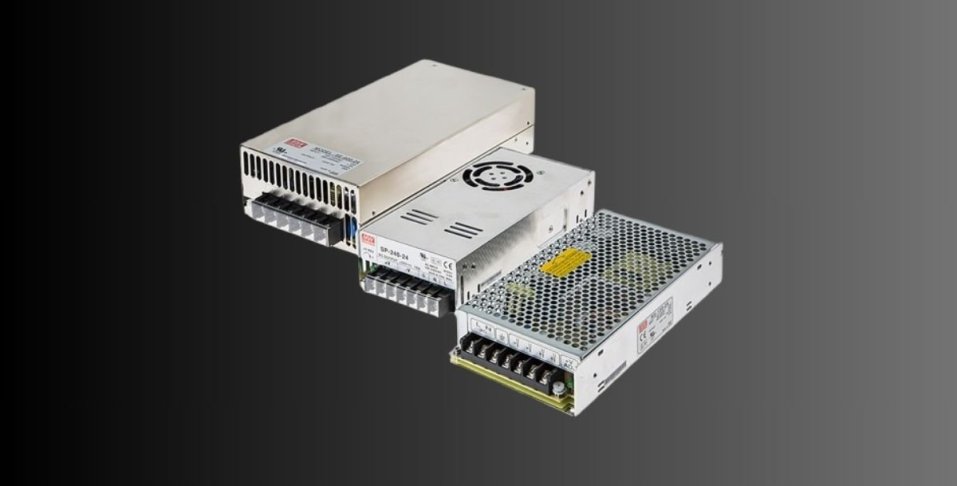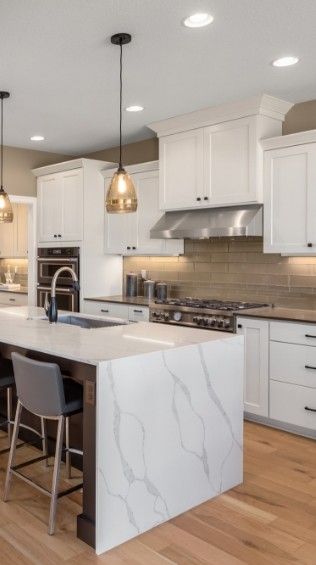Table of Contents
Solving Common Challenges with Power Supplies in Commercial Applications
Navigating the challenges associated with commercial power supply installation and operation is key to maximizing performance. Below, we address some of the most common issues encountered and provide practical solutions to overcome them.
Here are some common challenges with power supplies in commercial spaces:
1. Voltage Compatibility
Many commercial spaces operate on higher voltages (e.g., 277V or 480V), and mismatched power supplies can cause inefficiencies or failure. Most commercial buildings can have multiple voltages. Ensuring compatibility with the building's electrical system is critical.
Key Considerations:
-
Electrical System Assessment: Verify the frequency (usually 50-60 cycles) and area’s voltage where you intend to install the power supply to ensure compatibility.
-
Multi-Voltage Power Supplies: To handle varying voltages, opt for power supplies with wide input ranges (e.g., 100-277V or 277-480V).
-
Step-Down Transformers: Use transformers for converting high voltages (e.g., 480V to 277V) when needed.
-
Voltage Regulation: Choose supplies with voltage regulation to protect against fluctuations.
-
Compliance: Ensure power supplies meet safety standards like UL or CE for high-voltage environments.
Properly addressing voltage compatibility ensures efficient, reliable operation and protects systems from potential damage.
Ensuring Compatibility with Legacy Systems When Upgrading to Modern LED Drivers
Upgrading to modern LED drivers often involves integrating new technologies with older legacy systems. Incompatibility issues can arise, leading to performance inefficiencies or system failures.
To ensure compatibility:
-
Evaluate existing wiring and infrastructure: Assess whether the current wiring supports the voltage and current requirements of the new LED drivers. Rewiring may be necessary for optimal performance.
-
Match voltage and current outputs: Verify that the power supply's output specifications align with the requirements of the existing lighting systems to avoid overloading or underpowering the LEDs.
-
Use retrofit kits and adapters: Retrofit kits are designed to bridge the gap between legacy systems and modern LED technology, making the transition smoother and more cost-effective. Upgrade to LED lighting using the existing housing to update without a complete fixture replacement.
-
Consult manufacturer guidelines: To ensure proper integration, refer to the installation guides provided by the LED fixture and power supply manufacturers.
Voltage Drop
In large facilities, long wiring runs can lead to voltage drops, resulting in reduced light output or inconsistent performance. This is most prominent in 12V systems. Proper wire sizing and power supply selection can mitigate this.
For more information about voltage drop, read this blog from our affiliate, Super Bright LEDs.
How Do You Calculate Voltage Drop?
Use the formula below to calculate voltage drop:
Vdrop = ( 2 x L x I x R ) ÷ 1000
Where:
-
L = One-way wire length (in feet)
-
I = Current (in amps)
-
R = Wire resistance (in ohms per 1,000 feet, based on wire gauge).


Preventing Voltage Drop in Systems Using 12V Power Supplies or 24 Volts 6 Amps Configurations
Voltage drop can significantly impact the performance of LED lighting systems, particularly in installations with longer cable runs. When using 12V power supplies or 24 volts 6 amps configurations, the risk of voltage drop increases as the distance between the power source and the light fixtures grows. This can result in dimming, inconsistent brightness, or even failure of the LED lights.
To reduce the impact of voltage drop:
-
Use appropriately gauged wires: Thicker wires with lower resistance reduce the risk of voltage loss over long distances. For extended runs, consider upgrading to a lower-gauge cable.
-
Minimize the distance: Position power supplies closer to the LED fixtures whenever possible. This reduces the length of the wiring and the potential for voltage drop.
-
Consider higher voltage systems: Switching to 24V or even 48V systems can help mitigate voltage drop, as higher voltage systems experience less loss over the same distance.
-
Utilize multiple power supplies: For large installations, distributing the load across multiple power supplies can prevent overloading a single supply and reduce the risk of voltage drop.
2. Load Capacity Issues
Undersized or overloaded power supplies can lead to overheating, reduced lifespan, or performance degradation of the lighting system.
Key Considerations for Managing Load Capacity:
-
Accurate Load Calculations: Determine the total wattage of all connected fixtures and ensure it does not exceed the power supply's maximum rated capacity. Allow a safety margin (typically 10-20%). This accounts for potential load fluctuations.
-
Even Load Distribution: In larger installations, distribute the load evenly across multiple power supplies to prevent overloading a single unit.
-
Inrush Current Handling: Account for inrush currents, which occur when LEDs are powered on. Usually, the safety margin percentage should cover this.
-
Thermal Management: Install power supplies in well-ventilated areas to prevent overheating under high loads. Consider models with built-in thermal protection for added safety.
-
Load Monitoring: Use systems that monitor load conditions in real-time to identify potential overloading or inefficiencies before they cause failures.
By properly sizing and managing the load, commercial facilities can extend the lifespan of power supplies, maintain consistent performance, and reduce downtime.
How to Calculate the Electrical Load Capacity
-
Determine Total Wattage: Add up the wattage of all connected bulbs or fixtures. Use the maximum wattage for variable loads.
-
Calculate Current: Divide the total wattage by the input voltage to find the required amperage:
Current (Amps) = Total Wattage ÷ Voltage
-
Add a Safety Margin: Increase the total wattage by 10-20% to account for fluctuations or future expansion.
-
Check Power Supply Ratings: Ensure the power supply’s wattage and current ratings exceed the adjusted load.
-
Account for Inrush Current: Choose a power supply with sufficient inrush current capacity for LED fixtures.
Example:
-
Total Wattage: 800W
-
Voltage: 120V
-
Safety Margin: 20%
Adjusted Wattage = 800W x 1.2 = 960W
Required Current = 960W120V = 8A
The power supply must support at least 960W and 8A.
3. Environmental Factors
Commercial power supplies must withstand dust, moisture, extreme temperatures, and vibrations. Addressing these factors ensures reliability and longevity.
-
IP Ratings: Choose IP65+ for dust and water exposure; IP67 for harsh or outdoor environments.
-
Temperature Range: Select power supplies rated for extreme temperatures (e.g., -40°C to 85°C) and ensure proper heat management.
-
Humidity Resistance: Use moisture-resistant coatings or sealed designs for humid locations.
-
Vibration Protection: Install vibration-resistant supplies with secure mounts in facilities with heavy machinery.
-
Corrosion Resistance: Opt for corrosion-resistant enclosures in environments with salt or chemicals.
-
Outdoor Use: Protect with weatherproof enclosures, weatherproof connectors, UV-resistant materials, and surge protection.
-
Dusty Areas: Use sealed power supplies to prevent overheating from dust buildup.
Selecting power supplies designed for environmental challenges ensures consistent performance and durability in demanding settings.
4. Dimming Compatibility
Ensuring power supplies are compatible with dimming systems is crucial for precise lighting control and energy savings in commercial environments.
Important Factors:
- Dimming Methods:
-
TRIAC: Phase-cut dimming for simpler setups.
-
0-10V: Common in commercial applications for smooth dimming.
-
DALI: Advanced networked control for programmable systems.
-
PWM: Flicker-free dimming for LED drivers (only available for low voltage).
-
- Compatibility Checks: Confirm the power supply matches the dimming protocol of the control system.
-
Preventing Flicker: Use dimming-compatible drivers and power supplies for consistent performance.
5. Power Factor
Power factor measures how efficiently a device converts electrical power into usable energy. A low power factor indicates inefficiency, where more current is drawn than necessary, increasing energy costs and potentially leading to utility penalties in commercial settings. A good power factor is 0.90 or higher.
-
0.95+ is excellent and often required for energy-efficient systems.
-
0.99 (near unity/close to 1.0) is ideal for industrial and commercial use.
Key Considerations:
-
Reducing Costs: Efficient power supplies lower current draw, reducing operating costs and strain on the electrical system.
-
Compliance: Many energy codes and certifications require high power factor performance for commercial installations.
Maintaining a high power factor ensures efficient energy use, reduces costs, and supports a stable electrical system in commercial environments.
6. Harmonic Distortion
Poor-quality power supplies may create harmonic distortions, interfere with other electrical equipment, and reduce overall power efficiency. Harmonic distortion occurs when non-linear loads, like power supplies and LED drivers, introduce harmonics into the electrical system. This can disrupt equipment, reduce efficiency, and cause overheating.
Effects:
-
Equipment Disruption: Sensitive devices like HVAC systems and computers may malfunction.
-
Energy Loss: Harmonics increase inefficiencies and operating costs.
-
Overheating: Transformers, cables, and power supplies may overheat or fail.
-
Voltage Issues: Harmonics can distort voltage, causing flickering or inconsistent lighting.
Mitigation Strategies:
-
Install Harmonic Filters: A harmonic filter is a device used to reduce or eliminate harmonic distortion in electrical systems, improving power quality and protecting equipment from disruptions caused by non-linear loads.
-
Distribute Non-Linear Loads: Spread loads across circuits to avoid overloading.
-
Use Isolation Transformers: An isolation transformer separates the input and output circuits to block electrical noise, harmonics, and DC, improving power quality, protecting equipment, and ensuring safety.
-
Upgrade Infrastructure: Ensure components can handle harmonic loads effectively.
Managing harmonic distortion improves efficiency, protects equipment, and ensures consistent lighting performance.
7. EMI/EMC Compliance
Electromagnetic interference (EMI) and electromagnetic compatibility (EMC) compliance ensure that power supplies do not interfere with or disrupt other electronic devices in commercial environments.
What is Electromagnetic Interference (EMI)?
Electromagnetic Interference (EMI) refers to unwanted electromagnetic signals generated by power supplies or other equipment. These signals can disrupt nearby electronics, such as communication systems or sensitive devices.
What is EMI Testing?
Electromagnetic Interference (EMI) Testing focuses specifically on measuring and controlling a device's unwanted electromagnetic emissions. It ensures the device’s emissions fall within acceptable limits to prevent interference with other electronic systems.
Key Components of EMI Testing:
-
Radiated Emissions Testing: Measures electromagnetic noise emitted through the air from the device.
-
Conducted Emissions Testing: Assesses noise transmitted through power lines or connected cables.
EMI testing ensures that a device meets regulatory limits, such as those outlined by different standards, for emissions to avoid disrupting other systems in its operational environment.
What is Electromagnetic Compatibility (EMC)?
Electromagnetic Compatibility (EMC) ensures that power supplies operate without generating excessive EMI and remain unaffected by external electromagnetic signals.
What is EMC Testing?
Electromagnetic Compatibility (EMC) Testing evaluates a device's ability to function properly in its intended environment without causing or being affected by electromagnetic interference. EMC testing ensures that a device operates reliably alongside other electronic equipment.
Key Components of EMC Testing:
-
Emission Testing: Verifies that the device does not emit excessive electromagnetic noise that could interfere with nearby equipment.
-
Immunity Testing: Assesses the device’s ability to resist electromagnetic noise from external sources without performance degradation.
EMC testing typically follows industry standards and includes tests like radiated emissions, conducted emissions, and electrostatic discharge (ESD) immunity.
Importance of EMI/EMC Compliance
-
Prevents disruptions in critical systems like HVAC, medical equipment, or communication networks.
-
Ensures safety and reliability of power supplies in high-density commercial spaces.
-
Meets industry standards and regulatory requirements (e.g., FCC Part 15, CISPR, EN 55032).
EMI/EMC Mitigation Strategies
-
Shielding: Use power supplies with metal housings or shielding to block electromagnetic emissions.
-
Filtering: EMI filters can suppress unwanted signals and prevent interference.
-
Grounding: Proper grounding reduces the risk of stray electromagnetic signals affecting performance.
-
Design Considerations: Choose power supplies specifically tested for EMI/EMC compliance to ensure compatibility in commercial environments.
By ensuring EMI/EMC compliance, facilities can maintain uninterrupted electronics operation, reduce equipment downtime, and adhere to regulatory standards for electromagnetic performance.
Optimize Your Commercial Power Supply Performance
Our power supply experts can help you select the right power supply for your project. Contact our knowledgeable staff via phone, email, or live chat. We also have Commercial Accounts available. They are available to address any questions or concerns. Teams provide assistance before, during, and after project completion, including guidance on selecting the right power supplies.




